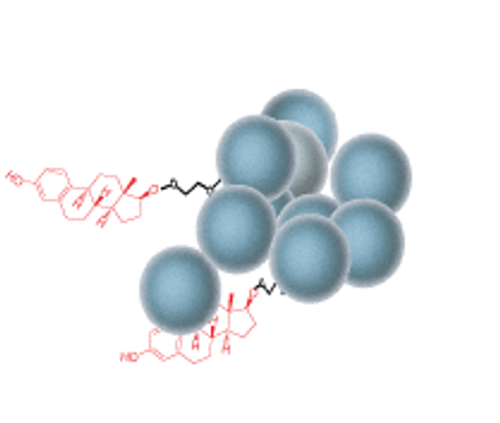Product Description
| Download Documents | |
| SDS | USER MANUAL |
CellMosaic® has designed this personalized immobilization kit for small molecule containing amine functional group. The user supplies the small molecule amine. Using the kit components, the customer immobilizes the small molecule amine onto SepSphere™ glyoxyl agarose in one step following CellMosaic® standard protocol.
This kit is custom made to order.
Some small molecules may contain other functional groups that can interfere with the reaction. We recommend that customers first email information about their small molecule before placing an order for this kit so we can provide insight into the efficacy of this kit and potentially present alternative options.
Key Features of this Immobilization Kit:
-
Minimum requirement for immobilization set-up
-
All reagents, buffers, and plasticwares are included
- Stable attachment
-
Easy preparation with air push mechanism for washing
-
Less than 2 h hands-on time
Specification of the Solid Support
- Functional groups: Glyoxyl
- Matrix: 4% beaded agarose (source: GE Life Sciences, Sepharose® 4B)
- Particle size: 45-165 um
- Mean bead size: 90 um
- Ligand concentration: ~20 μmol glyoxyl per mL agarose
Specification of the Immobilized Product
- Immobilized chemistry: immobilized via glyoxyl agarose and reduction
- Chemical stability: stable
- pH Stability: stable
Requirement for Small Molecule
- Preferably >90% pure by C18 HPLC
- Total amount: 1-10 mg
- Stable at pH 10.0 and reducing condition
Frequently Asked Questions:
The list below includes FAQs that are specific to this product.
Question: How do I incubate the immobilized small molecule agarose beads with cell lysates?
Answer: This kit is for preparing small molecules immobilized onto agarose beads. After the washing step in B11, the resin immobilized with the small molecule is ready for usage. Just add the cell lysates directly to the column with the bottom plugged if you are using all the resin in a column format or take some resin out and add to the cell lysates in a centrifuge tube/spin column. The amount of resin you will use depends on the binding capacity of your small molecule and the amount of protein you would like to capture. Nutate the column at RT for a few hours or overnight. The time for incubation depends on how strong and fast your small molecule can bind to the protein. After incubation, you will wash with water or PBS similar to step B11.
Question: How do I dissociate the binding between my small molecule and the protein?
Answer: When you are trying to dissociate your small molecule and protein, you can change the pH (low or high), use high salt (ionic strength), or use detergents or chaotropic agents that can denature one or both of the molecules. For Western blotting or LC-MS, your protein doesn’t need to be active (can be denatured). Unfortunately, which buffer to use will depend entirely on the small molecule and protein interaction. You can figure it out by trying a few conditions. You may be able to find some of these conditions in the literature. I would suggest trying an acidic buffer first, such as 0.1M sodium citrate (pH 3.3) or 0.1M glycine buffer. These are commonly used for disrupting protein A and antibody interaction. For LC-MS, try to avoid using any detergent as this will suppress the signal.
Question: How can I make bead-only samples for control?
Answer: If you want a simple control, you can use any of the non-modified agarose beads. If you want to use an exact control, you may need to use another kit to prepare a control with a non-binding small molecule amine.
If you can’t find the answer you’re looking for or need information on general topics, please visit the main Frequently Asked Questions (FAQs) section.










